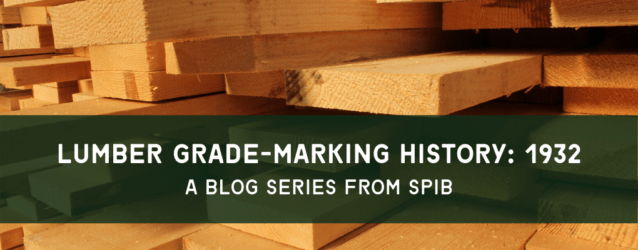On January 4, Luftwaffe Colonel Hermann Goring would assume control over most of the war industries in Germany – bringing with him harrowing implications for Europe during a time when World War II (as it would soon become known) was still in its early stages.
Continue readingGraded Lumber

Lumber Grade Marking History: 1939
The face of pop culture was forever changed in May of 1939 when Batman – created by artists Bill Finger and Bob Kane – made his first appearance in Detective Comics #27. He was the second such superhero of his type to make his debut in a year, with Superman hitting the newsstands for the first time in 1938.
Continue reading
Lumber Grade Marking History: 1938
1937 was another banner year in the United States, both in ways that people could have predicted at the time and in many ways that they couldn’t. Early in the year, Howard Hughes set a new flight record by making his way via airplane from Los Angeles to New York City in just under seven and a half hours. In February, President Franklin D. Roosevelt proposed his plan to enlarge the Supreme Court of the United States.
Continue reading
Lumber Grade Marking History: 1937
1937 was another banner year in the United States, both in ways that people could have predicted at the time and in many ways that they couldn’t. Early in the year, Howard Hughes set a new flight record by making his way via airplane from Los Angeles to New York City in just under seven and a half hours. In February, President Franklin D. Roosevelt proposed his plan to enlarge the Supreme Court of the United States.
Continue reading
Lumber Grade Marking History: 1936
If you had to pick one word to describe the theme in the United States that permeated across 1936, that word would undoubtedly be “innovation.” Even though the country was still reeling from the devastating effects of the Great Depression, innovation was happening across the United States.
Continue reading
Lumber Grade Marking History: 1935
The door to a particularly fascinating era in United States history was officially closed on May 30 when Babe Ruth – then playing for the Boston Braves – took the field for what would be his last career game against the Philadelphia Phillies.
Continue reading
Lumber Grade Marking History: 1934
At the same time, 1934 was also a period of uncertainty (and, some might say, trouble) for the industry – and for the Lumber Code Authority in general. Grade-marking was seen as an incredibly important subject, for example, but it was fully submerged in code difficulties at the time.
Continue reading
Lumber Grade Marking History: 1933
One of the most significant communication-related events of the early 20th century happened in March of 1933, although nobody at the time would have had any way of knowing that quite yet.
It was then that President Franklin D. Roosevelt, as a result of the Great Depression, addressed the nation for the first time during one of his famous “Fireside Chats.” Just a few days later, on March 15, the Dow Jones Industrial Average rose from 53.84 to 62.10. Despite the fact that the country was still in the throes of the Depression itself, this gain of 15.34% still marks the largest single-day percentage gain for the index in its history.

Lumber Grade-Marking History: 1932
In 1932, the country was still battling the impact of the Great Depression – and this was particularly evident across the lumber industry. These depressed economic conditions – coupled with the efforts of certain types of middlemen to create grade substitution opportunities and to evade quality and grade-marked lumber use – gave way to a series of dramatic changes in specifications and regulations in federal purchasing departments, state highway departments and other offices writing inquiries for lumber.
Continue reading
Lumber Grade-Marking History: 1931
In 1931, the Southern Pine Association extended the availability of its services and facilities, in the interests of grade-marked lumber production, to nonsubscriber mills or manufacturers.
Continue reading
